Axillary bud - Study guides, Class notes & Summaries
Looking for the best study guides, study notes and summaries about Axillary bud? On this page you'll find 119 study documents about Axillary bud.
Page 3 out of 119 results
Sort by

-
Louisiana Horticulture Exam study guide 2024 Questions and Answers Graded A
- Exam (elaborations) • 26 pages • 2024
-
- $12.99
- + learn more
4 major plant parts include - roots stems leaves reproductive parts 4 functions of the root system include - absorption anchorage conduction storage 2 kind of root systems found in plants are - fibrous root systems and taproot systems Fibrous root system - root system that consists of numerous multi-branched roots that are slender; no one root is more prominent than the other. Tap root system (more difficult to transplant) - root system that consists of one main root that gro...
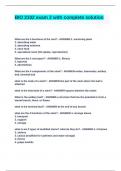
-
BIO 2102 exam 2 with complete solution
- Exam (elaborations) • 5 pages • 2024
-
- $11.49
- + learn more
What are the 5 functions of the root? 1. anchoring plant 2. absorbing water 3. absorbing nutrients 4. store food 5. specialized roots (O2 uptake, reproduction) What are the 3 root types? 1. fibrous 2. taproots 3. adventitious Previous Play Next Rewind 10 seconds Move forward 10 seconds Unmute 0:01 / 0:15 Full screen Brainpower Read More What are the 4 components of the stem? nodes, internodes, axillary bud, terminal bud what is the node of a stem? the...
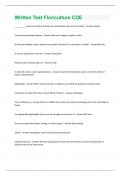
-
Written Test Floriculture CDE Questions And Answers
- Exam (elaborations) • 9 pages • 2024
-
- $7.99
- + learn more
__________ buds are found at the base of a leaf petiole and next to the stem - Answer-Axillary 4 necessary growing mediums - Answer-Nutrients, oxygen, support, water A chemical additive used to prevent the growth of bacteria in vase water is called? - Answer-Biocide A circular design does not have - Answer-focal point A plant with a tunicate bulb is a - Answer-Tulip A solenoid valve is used in greenhouses: - Answer-As an electrical device used to control the flow of water in greenhouses A...
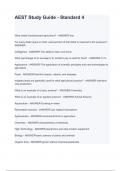
-
AEST Standard 24- cell tissue/cell culture techniques
- Exam (elaborations) • 4 pages • 2024
-
Available in package deal
-
- $7.99
- + learn more
AEST Standard 24- cell tissue/cell culture techniques What is often the major source of explants for tissue culture? - ANSWER-the meristematic ends of the plants like the stem tip or axillary bud What are the major benefits of plant tissue culture? - ANSWER-The ability to quickly produce mature plants, produce multiples of plants in the absence of seeds or pollinators, produce copies of plants with desirable traits, produce plants that otherwise have a low chance of germinating, mass prop...
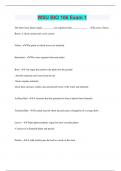
-
WSU BIO 106 Exam 1 | 2023 | 60 Questions with 100% Correct Answers | Updated & Verified
- Exam (elaborations) • 8 pages • 2023
- Available in package deal
-
- $10.49
- + learn more
The three basic plant organs, ________, are organized into_____________. - Leaves, Stems, Roots; A shoot system and a root system Nodes - The point at which leaves are attached Internodes - The stem segments between nodes Root - -An organ that anchors the plant into the ground -Absorbs minerals and water from the tip -Stores organic nutrients -Root hairs increase surface area and absorb most of the water and minerals Axillary Bud - A structure that has potential to form a lateral shoot (...
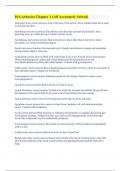
-
ISA Arborist Chapter 1 (All Accurately Solved)
- Exam (elaborations) • 7 pages • 2023
-
Available in package deal
-
- $10.49
- + learn more
Abscission Zone correct answers Area at the base of the petiole where cellular break down leads to leaf and fruit drop. Absorbing root correct answers Fine,fibrous roots that take up water and minerals. Most absorbing roots are within the top 12 inches (30cm) of soil. Adventitious bud correct answers Bud arising from a place other than a leaf axil or shoot tip,usually as a result of hormonal triggers. Aerial root correct answers Aboveground roots. Usually adventitious in nature and some...

-
EXPH 240 Exam 3 Questions With 100% Verified Answers
- Exam (elaborations) • 17 pages • 2024
-
- $12.49
- + learn more
EXPH 240 Exam 3 Questions With 100% Verified Answers The blood is responsible for - answer-transporting oxygen, nutrients, and hormones to body cells -carrying wastes away from the cells the lymphatic system functions to - answer-protect the body by filtering microorganisms and foreign particles from the lymph -support activities of the lymphocytes in the immune response -maintain the body's internal fluid environment as an intermediary between the blood in the capillaries and tissue c...
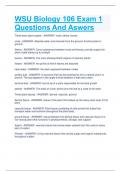
-
WSU Biology 106 Exam 1 Questions And Answer
- Exam (elaborations) • 9 pages • 2023
-
- $11.99
- + learn more
WSU Biology 106 Exam 1 Questions And Aswers Three basic plant organs - ANSWER- roots, stems, leaves roots - ANSWER- Absorbs water and minerals from the ground. Anchors plant in ground. Stems - ANSWER- Carry substances between roots and leaves; provide support for plant; holds leaves up to sunlight leaves - ANSWER- The main photosynthetic organs of vascular plants. Nodes - ANSWER- the points at which leaves are attached internodes - ANSWER- the stem segments between nodes axillary bud...
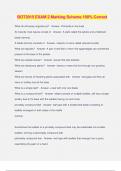
-
BOT3015 EXAM 2 Marking Scheme 100% Correct
- Exam (elaborations) • 10 pages • 2024
- Available in package deal
-
- $12.49
- + learn more
BOT3015 EXAM 2 Marking Scheme 100% Correct What do all leaves originate as? - Answer- Primordia in the buds At maturity most leaves consist of - Answer- A stalk called the petiole and a flattened blade (lamina) A blade (lamina) consists of - Answer- network of veins called vascular bundle What are stipules? - Answer- A pair of leaf-like or thorn-like appendages are sometimes present at the base of the petiole What are sessile leaves? - Answer- leaves that lack petioles What are deciduous...
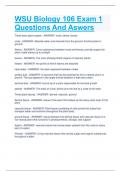
-
WSU Biology 106 Exam 1 Questions And Aswers
- Exam (elaborations) • 9 pages • 2023
- Available in package deal
-
- $13.99
- + learn more
WSU Biology 106 Exam 1 Questions And Aswers Three basic plant organs - ANSWER- roots, stems, leaves roots - ANSWER- Absorbs water and minerals from the ground. Anchors plant in ground. Stems - ANSWER- Carry substances between roots and leaves; provide support for plant; holds leaves up to sunlight leaves - ANSWER- The main photosynthetic organs of vascular plants. Nodes - ANSWER- the points at which leaves are attached internodes - ANSWER- the stem segments between nodes axillary bud...

Do you wonder why so many students wear nice clothes, have money to spare and enjoy tons of free time? Well, they sell on Stuvia! Imagine your study notes being downloaded a dozen times for $15 each. Every. Single. Day. Discover all about earning on Stuvia


